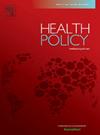Health care provider payment schemes and their changes since 2010 across nine Central and Eastern European countries – a comparative analysis
IF 3.6
3区 医学
Q1 HEALTH CARE SCIENCES & SERVICES
引用次数: 0
Abstract
Health care provider payment schemes consist of a complex set of arrangements used to influence provider behavior towards specific health policy objectives. The study aimed at: 1) providing a structured, comparative overview of current payment schemes within the public health system in selected Central and Eastern European (CEE) countries for different health care providers; 2) identifying and comparing major changes in payment schemes since 2010. Methods included: 1) data collection form development; 2) desk research; 3) national experts’ consultations; 4) comparative analysis. The results indicate that the nine CEE countries (Bulgaria, Croatia, Czechia, Estonia, Latvia, Lithuania, Hungary, Poland, and Romania) show numerous similarities in provider payment method mix and in the general direction of the recent changes conducted in this field. Output-based payment methods prevail across all countries and types of providers. Primary health care (PHC) providers are characterized by the most diverse payment method mix. PHC and hospital inpatient care have experienced the most frequent changes in their payment schemes within the last 13 years. These focused mostly on modifying existing payment methods (e.g. detailing payment categories), and applying additional methods to pay for specific services or performance (e.g. fee-for-service, bonus payments). The objectives of conducted change were often similar, thus, there is high potential for a shared, cross-country learning.
中欧和东欧9个国家自2010年以来医疗保健提供者支付计划及其变化——一项比较分析
卫生保健提供者支付计划包括一套复杂的安排,用于影响提供者的行为,以实现特定的卫生政策目标。该研究的目的是:1)在选定的中欧和东欧(CEE)国家,为不同的卫生保健提供者提供公共卫生系统内当前支付方案的结构化比较概述;2)识别和比较自2010年以来支付方案的主要变化。方法包括:1)数据收集表开发;2)案头研究;3)国家专家会诊;4)比较分析。结果表明,九个中东欧国家(保加利亚、克罗地亚、捷克、爱沙尼亚、拉脱维亚、立陶宛、匈牙利、波兰和罗马尼亚)在提供者支付方式组合和在这一领域最近进行的变化的总体方向上显示出许多相似之处。基于产出的支付方式在所有国家和类型的提供者中普遍存在。初级卫生保健(PHC)提供者的特点是付款方式组合最多样化。在过去13年中,初级保健和住院治疗的支付方案变化最为频繁。这些措施主要侧重于修改现有的支付方式(如详细说明支付类别),并应用额外的方式来支付特定的服务或绩效(如按服务收费、奖金支付)。所进行的变革的目标往往是相似的,因此,有很大的潜力进行共享的、跨国的学习。
本文章由计算机程序翻译,如有差异,请以英文原文为准。
求助全文
约1分钟内获得全文
求助全文
来源期刊

Health Policy
医学-卫生保健
CiteScore
6.40
自引率
6.10%
发文量
157
审稿时长
3-8 weeks
期刊介绍:
Health Policy is intended to be a vehicle for the exploration and discussion of health policy and health system issues and is aimed in particular at enhancing communication between health policy and system researchers, legislators, decision-makers and professionals concerned with developing, implementing, and analysing health policy, health systems and health care reforms, primarily in high-income countries outside the U.S.A.
 求助内容:
求助内容: 应助结果提醒方式:
应助结果提醒方式:


